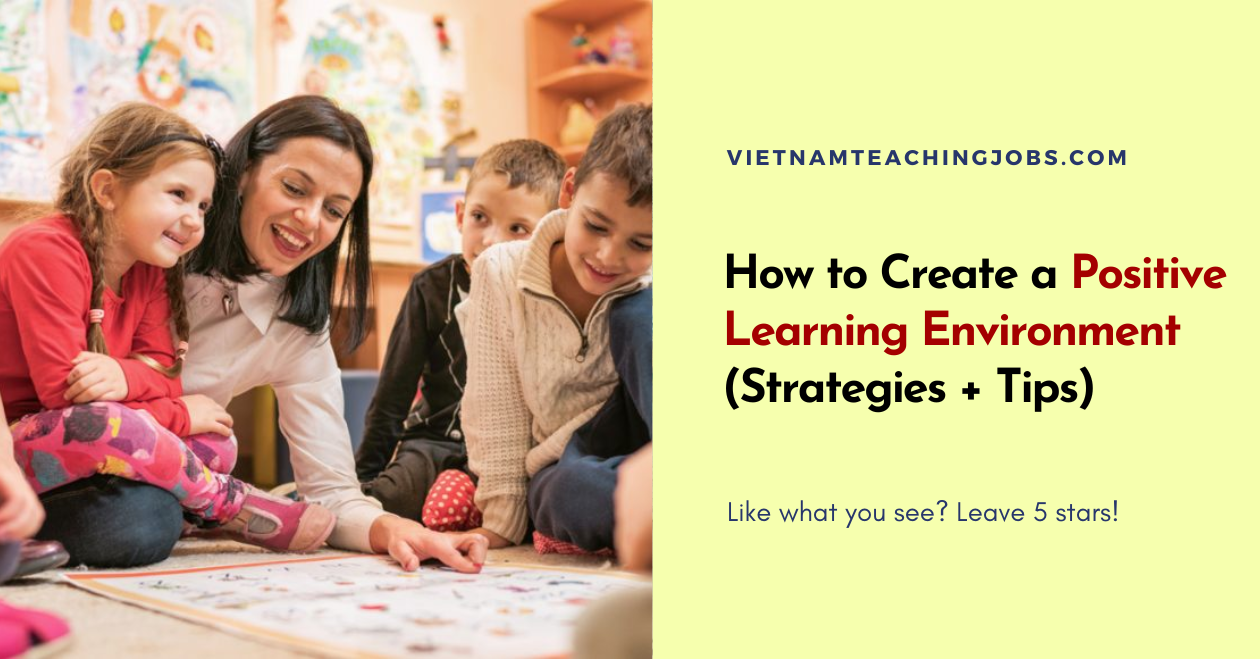Effective classroom management is crucial to creating a positive and effective learning environment. It involves a range of strategies and techniques that help teachers establish order, promote student engagement, and foster academic success. In this article, VTJ will explore over 20 effective classroom management strategies and techniques that can be applied to improve behavior in the classroom.
>>>Read more: 14 Types of teaching methods for an effective lesson
Universal classroom management strategies for educators

Classroom management strategies are necessary for educators to create a conducive learning environment
Universal classroom management strategies are necessary for educators to create a conducive learning environment. These strategies can be applied across different grade levels and subjects. By implementing these strategies, educators can establish order, promote student engagement, and create optimal learning experiences for all students. Universal classroom management strategies focus on setting clear expectations, fostering positive relationships, using effective communication techniques, implementing consistent and fair consequences, and creating a structured and supportive classroom environment. These strategies empower educators to effectively manage behavior in the classroom, enhance student motivation, and maximize academic achievement. Here are some strategies to help you manage behavior in the classroom:
Model ideal behavior
Modeling ideal behavior is a crucial method in managing behavior in the classroom. As an educator, it is essential to lead by example and demonstrate the behavior you expect from your students. By consistently displaying positive and respectful behavior, you create a role model for students to emulate. This includes showing attentiveness, using appropriate language, adhering to classroom rules, and treating others with kindness and respect. Modeling ideal behavior not only establishes standards for students but also fosters a positive and conducive learning environment.
>>>Read more: 17 Transferable Teaching Skills: Unlock Your Dream Job
Build relationships with your students
Developing strong relationships with your students is key to approaching and managing their behavior in the classroom. Take the time to get to know each student, show a genuine interest in their lives, and establish a sense of trust. When students feel cared for and understood, they are more likely to adjust their behaviors to be positive. Some ways to help you establish close relationships with students such as providing constructive feedback, acknowledging their achievements, encouraging collaborative activities, showing empathy and understanding, and engaging parents/guardians.
>>>Read more: How to use CHATGPT in teaching and learning
Communicate positively with families
Maintaining open lines of communication with students’ families is crucial in nurturing a positive attitude in students. Regularly updating parents/guardians about their child’s progress, and any concerns is essential. Collaborating with families to reinforce behavior expectations at home and at school helps create a consistent approach in promoting positive behavior.
>>>Read more: Practical Tips to Deal with Negative Teacher
Document rules
Setting clear and concise behavior expectations from the beginning of the school year lays the foundation for successful classroom management. You need to set certain limits on student behavior in the classroom. Clearly communicate the rules, routines, and consequences to your students. Ensure that they understand the expectations and consequences of their actions.
Let students help establish guidelines
Allowing students to participate in the process of establishing guidelines can be a powerful approach in classroom management. By involving students in the creation of behavior guidelines, they develop a sense of ownership and responsibility for their actions. Encourage open discussions and brainstorming sessions where students can share their ideas and perspectives on how the classroom should operate. Collaboratively determine expectations, rules, and consequences that align with their needs and promote a positive learning environment. When students have a voice in setting the guidelines, they are more likely to understand and adhere to them, leading to increased engagement and cooperation in the classroom.
>>>Read more: 15+ Ways to build confidence in your ESL students
Avoid punishing the class
Allowing students to participate in the process of establishing guidelines can be a powerful approach to behavior management in the classroom. By involving students in the creation of behavior guidelines, they develop a sense of ownership and responsibility for their actions. Encourage open discussions and brainstorming sessions where students can share their ideas and perspectives on how the classroom should operate. Collaboratively determine expectations, rules, and consequences that align with their needs and promote a positive learning environment. When students have a voice in setting the guidelines, they are more likely to understand and adhere to them, leading to increased engagement and cooperation in the classroom.
>>>Read more: What is blended learning? Types, Examples & Benefits?
Encourage initiative
Encouraging initiative in the classroom is a powerful way to promote student growth and development. When students are empowered to take the initiative, they become active participants in their own learning journey. By providing opportunities for independent thinking, problem-solving, and decision-making, educators can nurture essential skills such as critical thinking, creativity, and responsibility. Encouraging initiative also fosters a sense of ownership and engagement, as students feel proud and accomplished in their learning journey.
>>>Read more: Different types of institutions to teach English in Vietnam
Offer praise
Offering praise is a valuable tool in supporting the classroom environment. When educators provide genuine and specific praise to students, it reinforces their efforts, boosts their confidence, and motivates them to continue their hard work. By recognizing and acknowledging students’ achievements, progress, and positive behaviors, educators cultivate a sense of accomplishment and self-worth. Effective praise focuses on specific strengths and efforts, highlighting the value of students’ contributions. It is important to offer praise consistently, authentically, and in a manner that is individualized to each student, fostering a culture of encouragement and celebrating the unique qualities and successes of every student in the classroom.
Use non-verbal communication
Through facial expressions, body language, and gestures, educators can convey important messages. Non-verbal cues, such as a smile, nod, or eye contact, can communicate attentiveness, encouragement, and support to students. It helps to establish rapport, build trust, and strengthen teacher-student relationships. Additionally, using non-verbal cues like hand signals or visual cues can help with transitions, classroom routines, and behavior management in the classroom. By being mindful of their own non-verbal communication and interpreting students’ non-verbal cues, educators can enhance classroom dynamics, promote effective communication, and foster a positive and inclusive learning environment.
Hold parties
Holding parties in the classroom can be a fun and engaging way to foster a sense of community and celebrate achievements. Parties provide an opportunity for students to come together, relax, and enjoy a break from regular academic routines. They can be organized to celebrate special occasions such as holidays, birthdays, or the completion of a project.
Parties can include games, music, decorations, and even themed activities to create a festive atmosphere. By organizing and participating in parties, educators create memorable experiences that promote social interaction, teamwork, and positive classroom culture.
Give tangible rewards
Providing tangible rewards in the classroom can be an effective way to motivate academic achievements. When used thoughtfully and in conjunction with other forms of positive reinforcement, tangible rewards can be a powerful tool in shaping student behavior, boosting self-esteem, and promoting a positive learning environment. It is important, however, to ensure that the focus remains on intrinsic motivation and fostering a genuine love for learning. Tangible rewards serve as occasional supplements rather than the sole source of motivation.
Featured Job
Tangible rewards can take the form of certificates, stickers, small prizes, or other tangible items that students can physically receive. These rewards serve as tangible symbols of recognition and accomplishment, creating a sense of pride and incentive for students to continue their efforts.
Build excitement for content and lesson plans
Building excitement for content and lesson plans is a key element in engaging students and creating a dynamic learning environment. Educators can use various strategies to generate enthusiasm and anticipation among students. One approach is to introduce the content in a captivating and intriguing way, such as through a thought-provoking question, a stimulating video, or a real-life example. Incorporating interactive and hands-on activities, group discussions, and multimedia resources can also help capture students’ interest and make the content more relatable and meaningful. By creating a classroom culture that values curiosity, discovery, and active participation, educators can foster a genuine excitement for learning and encourage students to become enthusiastic participants in their own education.
Offer different types of free study time
Providing various self-study periods within classroom settings offers valuable opportunities for students to choose research activities they enjoy. Free study time can also be structured to include options such as collaborative group work, independent research, or practical experimentation, catering to different learning styles and preferences. Offering multiple choices for study time allows students to pursue their interests, delve deeper into the topics they choose, and simultaneously develop curiosity and a passion for learning. It helps students become self-motivated, time-managing individuals and fosters a sense of responsibility for their own education. By combining different types of study time, educators create a dynamic and engaging learning environment, nurturing independent thinking, fostering a love for learning, and assisting students in becoming self-directed learners.
Write group contracts
Group contracts are an essential component of effective classroom management strategies. These contracts serve as a collaborative agreement between students, outlining expectations, responsibilities, and guidelines for working together in groups. By involving students in the process of creating group contracts, they feel a sense of ownership and accountability for their actions within the group. Group contracts establish clear communication channels, establish norms for respectful and inclusive behavior, and promote cooperation and teamwork. They also provide a framework for conflict resolution and problem-solving, ensuring that any issues that arise within the group can be addressed in a constructive and fair manner.
Assign open-ended projects
By providing students with the opportunity to explore a topic or problem in depth and allowing them to determine their own approaches and solutions. Open-ended projects foster creativity, critical thinking, and problem-solving skills. These projects encourage students to take ownership of their learning, as they are responsible for setting goals, managing their time, and making decisions throughout the process. Additionally, open-ended projects promote collaboration and communication, as students often work in teams or seek feedback from their peers. By embracing open-ended projects, educators create a dynamic and student-centered learning environment that encourages curiosity, independence, and a love for learning. Behavior management in the classroom approaches contribute to a student’s behavior management plan
Give only two scores for informal assessments
Giving only two scores for informal assessments is an effective classroom management strategy that simplifies the grading process and provides clear feedback to students. By using a binary scoring system, such as “meets expectations” or “needs improvement,” educators can focus on the essential learning objectives and provide targeted feedback to guide students’ progress. This approach reduces the complexity of grading and allows teachers to quickly assess student understanding and identify areas for improvement. Additionally, using only two scores for informal assessments promotes a growth mindset among students, emphasizing that mistakes and areas of improvement are part of the learning process. It also encourages students to take ownership of their learning and strive for continuous improvement.
Classroom management strategies for individual students

Classroom management strategies for individual students
Recognizing that each student is unique and may have different needs, these strategies aim to address individual behaviors, learning styles, and challenges. By implementing personalized approaches, educators can effectively engage and support students in their academic and social development. These strategies may include:
Use EdTech that adjusts to each student
Integrating educational technology (EdTech) is a powerful addition to classroom management strategies for individual students. By leveraging adaptive learning platforms or personalized digital tools, educators can provide tailored instruction and support to meet the unique needs of each student.
These technologies utilize data-driven algorithms to analyze student performance, identify areas of strength and weakness, and deliver targeted content and activities. This individualized approach allows students to learn at their own pace, receive immediate feedback, and engage in interactive and personalized learning experiences. EdTech also empowers students to take ownership of their learning, as they can track their progress, set goals, and access resources that cater to their specific needs.
Interview students
Interviewing students is an effective classroom management strategy for understanding and addressing the individual needs of students. By conducting one-on-one interviews, educators can gain valuable insights into students’ learning preferences, challenges, and interests. This information can then be used to tailor instructional approaches, provide appropriate support, and create a positive and inclusive learning environment. During the interviews, educators can ask open-ended questions to encourage students to express their thoughts, feelings, and concerns. By actively listening to students’ perspectives, educators can better understand their unique needs and develop personalized strategies to meet those needs. Additionally, student interviews foster a sense of trust, collaboration, and mutual respect between educators and students, which are essential for effective classroom management.
Address inappropriate or off-task behavior quickly
Addressing inappropriate or off-task behavior quickly is a crucial classroom management strategy when dealing with students. By promptly addressing such behavior, educators can maintain a positive and focused learning environment for all students. When inappropriate behavior occurs, it is important to address it privately and respectfully, ensuring that the student feels heard and understood. This can involve having a calm conversation with the student to discuss the behavior, its impact on the classroom, and the expectations for appropriate behavior. Implementing clear and consistent consequences for inappropriate behavior helps students understand the boundaries and encourages them to make better choices in the future.
Consider peer teaching
Peer teaching is an effective classroom management strategy that benefits both the individual student and the overall classroom environment. By incorporating peer teaching, educators can create opportunities for students to take on the role of teachers and share their knowledge with their peers. This strategy not only helps reinforce the understanding of the student but also provides a supportive and collaborative learning environment for the entire class. Peer teaching encourages active engagement, critical thinking, and communication skills among students. It also promotes a sense of responsibility and accountability as students take ownership of their learning and support their classmates.
Gamify personal learning plans
Gamifying personal learning plans is an innovative approach to behavior management in the classroom that can greatly benefit individual students. By incorporating game elements into the learning process, such as goal-setting, points and rewards, levels and challenges, leaderboards, personalized learning paths, collaboration, and feedback, educators can create an engaging and interactive environment. This strategy not only motivates students to actively participate in their own education but also allows for tailored instruction that meets their unique needs and interests. Gamification of personal learning plans cultivates a positive and inclusive classroom community.
>>>Read more: Teaching English in Vietnam: The Complete Guide & How to Get Started?
FAQ
What are the 4 types of classroom management?
The four types of classroom management are authoritarian, authoritative, permissive, and indulgent
What is the best classroom management style?
The best classroom management style depends on various factors, including the teacher’s personality, the student’s needs and characteristics, and the educational environment.
What are the four components of classroom management?
The four components of classroom management are: Classroom Design, Instructional Technique, Classroom Rules, Organization
Why is classroom management so important?
Classroom management is important because it creates a positive learning environment where students feel safe, engaged, and motivated. It establishes clear expectations, rules, and procedures, minimizing disruptions and maximizing instructional time.
Are you facing difficulties in finding and securing teaching positions in Vietnam? Are visa procedures causing you trouble? Feeling overwhelmed and directionless upon your arrival in Vietnam for teaching assignments? Don’t worry, VTJ’s English Teaching Placement in Vietnam (EPIV) Program 2024 provides comprehensive support to solve ALL the matters.
👉👉👉 Click HERE to request free consultation




